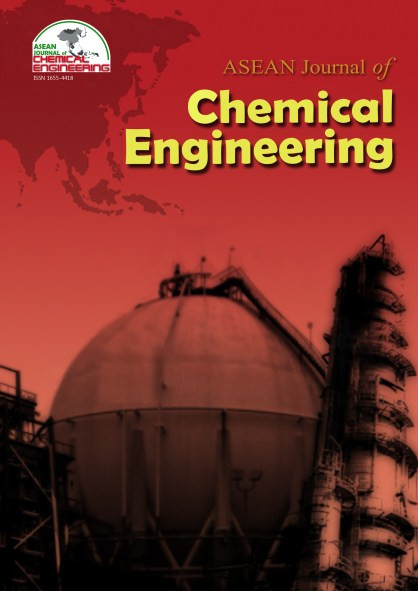Multi-objective Optimization of Succinic Acid Production from Empty Fruit Bunch
Abstract
Empty Fruit Bunch (EFB) produced in plantation mill activities in Malaysia creates a major disposal problem. On the other hand, sustainability issues have driven industries to overcome the depletion of fossil fuels and reduction of greenhouse gases emissions. Therefore, as a renewable source, EFB can be an attractive option to address the above problems by converting it into fuels and chemicals. Succinic acid, one of 12 chemical building blocks identified by DOE to be used in synthesis of high-value materials, can be produced from biochemical conversion of the EFB. The present study evaluates succinic acid production process using EFB as the raw material from the perspective of three pillars of sustainability, namely economic, environment, and safety. Flowsheet modeling and techno-economic analysis methods are applied, followed by a multi-objective optimization using genetic algorithm method that simultaneously accounts for maximization of Net Present Value (NPV) and minimization of both Global Warming Potential (GWP) and Toxicity Damage Index (TDI). The pareto frontier reveals a trade-off among all objectives that the maximum NPV is 1,619 MMSD at the maximum EFB of 71,900 kg/hour. Meanwhile, the minimum GWP (12.4 kg CO2-eq/kg succinic acid) and TDI (4.5) are acquired at the minimum EFB of 50,000 kg/hour.
References
2. Akbari, A. and Barton, P.I. (2019). Integrating Genome-Scale and Superstructure Optimization Models in Techno-Economic Studies of Biorefineries. Processes, 7: 286.
3. Chang, S.H. (2014). An overview of empty fruit bunch from oil palm as feedstock for bio-oil production. Biomass and Bioenergy, 62: 174-181.
4. Júnior, J.C.F., Palacio, J.C.E., Leme, R.C., Lora, E.E.S., da Costa, J.E.L., Reyes, A.M.M., and del Olmo, O.A. (2019). Biorefineries productive alternatives optimization in the brazilian sugar and alcohol industry. Applied Energy.
5. Guinée, J. B. (2002). Handbook on life cycle assessment: operational guide to the ISO standards. Kluwer Academic Publishers, Dordrecht.
6. Humbird, D., Davis, R., Tao, L., Kinchin, C., Hsu, D., Aden, A., Schoen, P., Lukas, J., Olthof, B., Worley, M., Sexton, D., and Dudgeon, D. (2011). Process Design and Economics for Biochemical Conversion of Lignocellulosic Biomass to Ethanol: Dilute-Acid Pretreatment and Enzymatic Hydrolysis of Corn Stover.
7. Hurme, M. and Rahman, M. (2005). Implementing inherent safety throughout process lifecycle. Journal of Loss Prevention in the Process Industries, 18: 238-244.
8. International Organization of Standardization. (2006). Environmental Management: Life Cycle Assessment-Principles and Framework.
9. Jafari, M.J., Mohammadi, H., Reniers, G., Pouyakian, M., Nourai, F., Torabi, S.A., and Miandashti, M.R. (2018). Exploring inherent process safety indicators and approaches for their estimation: A systematic review. Journal of Loss Prevention in the Process Industries, 52: 66-80.
10. Khan, F.I. and Abbasi, S.A. (1998). Multivariate hazard identification and ranking system. Process Safety Progress, 17: 157-170.
11. Khuri, A.I., and Mukhopadhyay, S. (2010). Response surface methodology. Wiley Interdisciplinary Reviews: Computational Statistics, 2: 128-149.
12. Klein, B.C., Silva, J.F.L., Junqueira, T.L., Rabelo, S.C., Arruda, P.V., Ienczak, J.L., Mantelatto, P.E., Pradella, J.G.C., Junior, S.V., and Bonomi, A. (2017). Process development and techno- economic analysis of bio-based succinic acid derived from pentoses integrated to a sugarcane biorefinery. Biofuels, Bioproducts and Biorefining, 11: 1051-1064.
13. Klein, B.C., Chagas, M.F., Junqueira, T.L., Rezende, M.C.A.F., Cardoso, T.F., Cavalett, O., and Bonomi, A. (2018). Techno-economic and environmental assessment of renewable jet fuel production in integrated Brazilian sugarcane biorefineries. Applied Energy, 209: 290-305.
14. Lee, S.J., Song, H., and Lee, S.Y. (2006). Genome-based metabolic engineering of Mannheimia succiniciproducens for succinic acid production. Applied and Environmental Microbiology, 72: 1939-1948.
15. Liebal, U.W., Blank, L.M., and Ebert, B.E. (2018). CO2 to succinic acid - Estimating the potential of biocatalytic routes. Metabolic Engineering Communications, 7: e00075.
16. Özdenkçi, K., De Blasio, C., Muddassar, H.R., Melin, K., Oinas, P., Koskinen, J., Sarwar, G., and Järvinen, M. (2017). A novel biorefinery integration concept for lignocellulosic biomass. Energy Conversion and Management, 149: 974-87.
17. Pateraki, C., Patsalou, M., Vlysidis, A., Kopsahelis, N., Webb, C., Koutinas, A.A., and Koutinas, M. (2016). Actinobacillus succinogenes: Advances on succinic acid production and prospects for development of integrated biorefineries. Biochemical Engineering Journal, 112: 285-303.
18. Pinazo, J.M., Domine, M.E., Parvulescu, V., and Petru, F. (2015). Sustainability metrics for succinic acid production: A omparison between biomass-based and petrochemical routes. Catalysis Today, 239: 17-24.
19. Song, D., Yoon, E.S., and Jang, N. (2018). A framework and method for the assessment of inherent safety to enhance sustainability in conceptual chemical process design. Journal of Loss Prevention in the Process Industries, 54: 10-17.
20. Sy, C.L., Ubando, A.T., Aviso, K.B., and Tan, R.R. (2018). Multi-objective target oriented robust optimization for the design of an integrated biorefinery. Journal of Cleaner Production, 170: 496-509.
21. Tuazon, D. and Gnansounou, E. 2017. Towards an Integrated Sustainability Assessment of Biorefineries. Life-Cycle Assessment of Biorefineries, 259-301.
22. Werpy, T., Petersen, G. (2004). Top Value Added Chemicals from Biomass: Volume I--Results of Screening for Potential Candidates from Sugars and Synthesis Gas.
23. Abidin, M.Z., Rusli, R., Buang, A., Shariff, A.M., and Khan, F.I. (2016). Resolving inherent safety conflict using quantitative and qualitative technique. Journal of Loss Prevention in the Process Industries, 44: 95-111.
Copyright holder for articles is ASEAN Journal of Chemical Engineering. Articles published in ASEAN J. Chem. Eng. are distributed under a Creative Commons Attribution-NonCommercial 4.0 International (CC BY-NC 4.0) license.
Authors agree to transfer all copyright rights in and to the above work to the ASEAN Journal of Chemical Engineering Editorial Board so that the Editorial Board shall have the right to publish the work for non-profit use in any media or form. In return, authors retain: (1) all proprietary rights other than copyright; (2) re-use of all or part of the above paper in their other work; (3) right to reproduce or authorize others to reproduce the above paper for authors’ personal use or for company use if the source and the journal copyright notice is indicated, and if the reproduction is not made for the purpose of sale.



